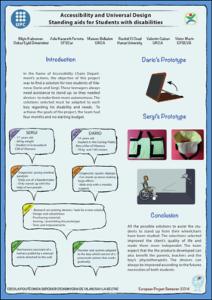Mostra el registre d'ítem simple
Accessibility & universal design: standing aids for students with disabilities
| dc.contributor | Vázquez, Juan José |
| dc.contributor | Musté Rodríguez, Marta |
| dc.contributor | Vállez, Raquel |
| dc.contributor.author | Kahraman, Bilgin |
| dc.contributor.author | Nazareth Ferreira, Julia |
| dc.contributor.author | Belkalem, Maïwen |
| dc.contributor.author | El Ouad, Rachid |
| dc.contributor.author | Calzan, Valentin |
| dc.contributor.author | Marín del Río, Víctor |
| dc.contributor.other | Universitat Politècnica de Catalunya. Departament d'Enginyeria Agroalimentària i Biotecnologia |
| dc.date.accessioned | 2014-11-06T10:08:02Z |
| dc.date.available | 2014-11-06T10:08:02Z |
| dc.date.issued | 2014-06 |
| dc.identifier.uri | http://hdl.handle.net/2099.1/23586 |
| dc.description | Treball desenvolupat dins el marc del programa 'European Project Semester'. |
| dc.description.abstract | In recent decades, the quality of life of many disabled people has improved. There are more and more devices for making handicapped people’s lives better. This accessibility has the aim of giving more independence to certain people with motor disabilities. Specifically, it focuses on two paraplegic children who have difficulties both in standing up from their wheelchairs as well as standing for short periods of time due to their condition. Therefore, they need a device that can help them to stand up from their wheelchair. This project was carried out in conjunction with a social organisation called Accessibility Chair with the objective to improve the quality of life of these two children and to make them less dependent on the help of other people. If successful, there are potentially many other children and adults that could benefit from the research that has been carried out and the prototype that has been designed and built by the team. The methods used to gain information about the subject and possible solutions include semistructured interviews, a questionnaire, desk‐research and field‐research. Desk and field research was done to find out what kind of existing products might aid these children. Meetings with the project supervisors, clients and physiotherapists also took place. After many brainstorming sessions as well as other creative sessions, the team decided on using multiple products together. Two different solutions were proposed and are detailed in the report. One is a winch combined with a harness, and the other is a pneumatic seat. In addition, the testing and improvement phases of our prototypes are explained as well. |
| dc.language.iso | eng |
| dc.publisher | Universitat Politècnica de Catalunya |
| dc.subject | Àrees temàtiques de la UPC::Enginyeria mecànica::Fabricació::Disseny i càlcul de màquines |
| dc.subject.lcsh | Electric wheelchairs |
| dc.subject.other | Accessibility |
| dc.subject.other | Disabled people |
| dc.subject.other | Harness |
| dc.subject.other | Paraplegic |
| dc.subject.other | Physiotherapists |
| dc.subject.other | Pneumatic seat |
| dc.subject.other | Prototype |
| dc.subject.other | Wheelchair |
| dc.subject.other | Winch |
| dc.title | Accessibility & universal design: standing aids for students with disabilities |
| dc.type | Bachelor thesis |
| dc.subject.lemac | Disseny industrial |
| dc.rights.access | Open Access |
| dc.audience.educationlevel | Grau |
| dc.audience.mediator | Escola Politècnica Superior d'Enginyeria de Vilanova i la Geltrú |
| dc.audience.degree | GRAU EN ENGINYERIA MECÀNICA (Pla 2009) |




